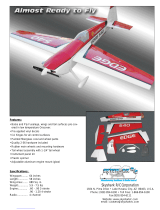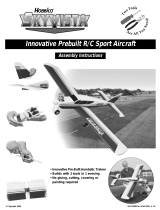
❑ 3 or 4 cell 3000-5000 mah LIPO BATTERY PACK
You can fly your 4-STAR 54 with a 3 cell (3S1P) or 4 cell (4S1P)
Lipo pack. Pack capacity should be 3000-5000 mah for good flight
duration. A 3 cell pack (11.1 volts) provides good flight perform-
ance with mild aerobatic capability. A 4 cell pack (14.8 volts) pro-
vides more power with outstanding aerobatic performance.
CAUTION: You must match your propeller size to the cell count of
your lipo pack, to avoid drawing too many amps and damaging
your ESC or motor.
❑ PROPELLER
With electric powered models there are many factors that have a
bearing on what propeller to use. The best place to start answer-
ing that question is in the instructions that come with your motor.
Another fine source of information is one of the electric flight cal-
culators that are available for you to use free online (there is a
good one on Castle Creations web site).
OUR FLIGHT TEST REPORT
After extensive test flying, our favorite setup for the 4-STAR 54 is
a 4250 (case dimensions) 770 kv brushless motor, with a 75 amp
ESC, 4S lipo battery pack, and an APC 13 x6.5 E propeller. This
combination gave outstanding flight performance. When using a
4S 3000 mah lipo, we had flight times around 6-8 minutes, de-
pending of course on throttle management. Your results may vary.
For more flight time use a larger pack. Prop size, size and quality
of the battery pack, throttle management, air temperature, etc.,
all have a bearing on electric flight performance and flight time.
Experiment to find the best combination for your setup.
❑ BATTERY CHARGER
FOR SAFETY AS WELL AS PERFORMANCE, CHARGE LIPO
BATTERIES ONLY
WITH A LIPO BATTERY CHARGER!
In addition to providing the critical charging profile needed to
safely charge lipo batteries, a lipo battery charger also includes
the capability of "balancing" the available voltage in the cells, en-
suring that the battery pack is at peak capacity at the end of the
charge cycle. This translates to better flight times and a longer
life from the battery pack.
REQUIRED TOOLS
For proper assembly, we suggest you have the following tools and
materials available:
A selection of glues - SIG Thin, Medium, & Thick CA Glue
CA Accelerator, CA Debonder
SIG Kwik-Set 5-Minute Epoxy
Screwdriver Assortment
Pliers - Needle Nose & Flat Nose
Diagonal Wire Cutters
Small Allen Wrench Assortment
Pin Vise for Small Dia. Drill Bits
Hobby Knife with Sharp #11 Blades
Small Power Drill With Selection of Bits
Dremel® Tool With Selection of Sanding & Grinding Bits
Scissors
Sandpaper
Covering Iron & Trim Seal Tool
Masking Tape, Paper Towels
Alcohol and/or Acetone For Epoxy Clean-up
COMPLETE KIT PARTS LIST
The following is a complete list of all parts contained in this kit.
Before beginning assembly, we suggest that you take the time to
inventory the parts in your kit. Use the check-off boxes ❑ pro-
vided in front of each part description. Please also note that the
bolts and nuts required to mount a glow engine to the engine
mounts are not included and must be purchased separately.
❑ (1) Fuselage
❑ (1) Right Wing Panel & Aileron, hinges not glued
❑ (1) Left Wing Panel & Aileron, hinges not glued
❑ (1) Aluminum Tube Main Wing Joiner
❑ (1) Horizontal Stabilizer & Elevator, hinges not glued
❑ (1) Vertical Fin & Rudder, hinges not glued
❑ (1) Fiberglass Cowling
❑ (4) M3 x 10mm Sheet Metal Screws, for cowl mounting
❑ (1) Clear Plastic Canopy
❑ (1) Pilot figure
Main Landing Gear
❑ (1) Aluminum Main Landing Gear
❑ (1) Right Fiberglass Wheel Pant
❑ (1) Left Fiberglass Wheel Pant
❑ (4) M3 x 12mm Socket-Head Bolts, for wheel pants
❑ (3) M4 x 20mm Socket-Head Bolts, for main gear
❑ (3) M4 Split-Ring Lock Washers
❑ (2) 4mm dia. Threaded Axles
❑ (2) 5mm Hex Nuts; for axles
❑ (4) 4mm ID Wheels Collars; for axles
❑ (2) 2-1/2” dia. Main Wheels
Tailwheel Assembly
❑ (1) Tailwheel Assembly, with wheel, Formed Wire, Nylon
Bearing, Wheel Collars(2)
❑ (1) Nylon Rudder Steering Control Clasp, with M2 x 15mm
Bolt and M2 Hex Nut
❑ (2) M3 x 12mm Sheet Metal Screws
Electric Motor Mount
❑ (1) Plywood Electric Motor Mount Assembly
❑ (1) Balsa Triangle Stock; for motor mount reinforcement
❑ (4) M4 x 20mm Socket-Head Mounting Bolts
❑ (4) M4 Flat Washers
❑ (4) M4 x 16mm Socket-Head Mounting Bolts
❑ (4) M4 Split-Ring Lock Washers
❑ (4) M4 Blind Nuts
Glow Engine Mounts, Fuel Tank, Throttle Pushrod
❑ (2) Nylon Engine Mounts; for glow engines
❑ (4) M4 x 20mm Mounting Bolts, for motor mount to firewall
❑ (4) M4 Flat Metal Washers, for motor mount to firewall
❑ (1) Fuel Tank
❑ (1) Rubber Stopper Assembly
❑ (1) Fuel Pick-Up Weight (clunk)
❑ (1) Fuel Line Tubing, for inside tank
❑ (1) Metal Pushrod Keeper with Set Screw
❑ (2) Hex Nuts for throttle servo connector
❑ (1) Plywood Fuel Tank Support
❑ (1) small Balsa Block; for fuel tank stop
Misc.
❑ (2) M6.5 x 45 mm Nylon Wing Bolts
❑ (4) Nylon Control Horns; for ail(2), ele(1), rud(1)
❑ (12) M2 x 12mm Screws; for control horns
❑ (4) Metal RC Clevis; for ail(2), ele(1), rud(1)
❑ (4) Small pieces of Fuel Tubing; for R/C clevis keepers
❑ (4) Pushrod Snap Keepers; for ail(2), ele(1), rud(1)
❑ (2) Plastic Cinch Straps
❑ (2) Hook-&-Loop (Velcro®) Straps
❑ (1) Strip of Covering Material
Pushrods
❑ (2) 28” long Wire Pushrods, threaded on one end, including
M2 Hex Nuts(2); for elevator & rudder
❑ (2) 7” long Wire Pushrods, threaded on one end, including
M2 Hex Nuts(2); for ailerons
❑ (1) 18.25” long Wire Pushrod, with Z-bend one end; for throttle
❑ (1) Nylon Pushrod Tube, for throttle
3

















